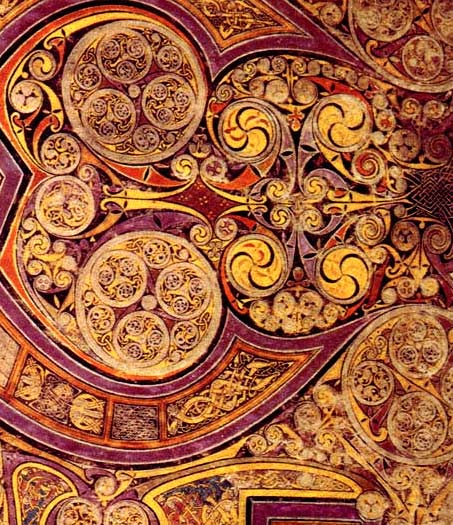| This Week’s Topic… | |

Best viewed in
|
The Book of Kells
The Book of Kells (Irish: Leabhar Cheanannais) sometimes known as the Book of Columba is an illuminated manuscript Gospel book in Latin, containing the four Gospels of the New Testament together with various prefatory texts and tables. It was created by Celtic monks ca. 800 or slightly earlier. The text of the Gospels is largely drawn from the Vulgate, although it also includes several passages drawn from the earlier versions of the Bible known as the Vetus Latina. It is a masterwork of Western calligraphy and represents the pinnacle of Insular illumination. It is also widely regarded as Ireland's finest national treasure. The illustrations and ornamentation of the Book of Kells surpass that of other Insular Gospel books in extravagance and complexity. The decoration combines traditional Christian iconography with the ornate swirling motifs typical of Insular art. Figures of humans, animals and mythical beasts, together with Celtic knots and interlacing patterns in vibrant colors, enliven the manuscript's pages. Many of these minor decorative elements are imbued with Christian symbolism and so further emphasize the themes of the major illustrations. The manuscript today comprises 340 folios and, since 1953, has been bound in four volumes. The leaves are on high-quality calf vellum, and the unprecedentedly elaborate ornamentation that covers them includes ten full-page illustrations and text pages that are vibrant with decorated initials and interlinear miniatures and mark the furthest extension of the anti-classical and energetic qualities of Insular art. The Insular majuscule script of the text itself appears to be the work of at least three different scribes. The lettering is in iron gall ink, and the colors used were derived from a wide range of substances, many of which were imports from distant lands.The manuscript takes its name from the Abbey of Kells that was its home for centuries. The Abbey is a former monastery located in Kells, County Meath, Ireland, 40 miles north of Dublin. It was founded in the early ninth century, and the Book of Kells was kept there during the later medieval and early modern periods before finally leaving the Abbey in the 1650s. Much of the Book of Kells may have been created there, but historians cannot be certain of the exact date and circumstances of its creation. The Abbey of Kells was first founded by St. Columba ca. 554. What some historians term a refounding happened in the early ninth century by Columban monks fleeing from Iona which was repeatedly raided by the Vikings. The site was a former Irish hill fort. In 814, Cellach, Abbot of Iona, retired to Kells. After further Viking raids, goods and relics from the abbey were transferred to other Columban houses inland, including Raphoe, Dunkeld and the Abbey of Kells. Some historians believe that the Book of Kells may have been either started in Iona and finished in Kells or written entirely in Kells by successive generation of monks. The Vikings continually raided the Abbey during the tenth century and it was repeatedly sacked and pillaged. Despite the constant raids, the monks managed to keep the Book of Kells intact until 1006 when it was stolen from the shrine. A reference in the Annals of Ulster is generally believed to refer the theft of the Book of Kells and it relates that the manuscript was returned after two months without its cover. The force of the removal of the cover probably explains the missing illustrations at the beginning and end of the book. The book was stored in the Abbey for the remainder of the Middle Ages. In the twelfth century, details of land charters for the abbey were copied onto blank pages of the Book of Kells as was common practice for the period. This is the earliest confirmed reference to its presence at the Abbey. Later in the same century, the monastery was dissolved with the abbey becoming a parish church and the Book of Kells continued to be kept there. Catholic landowners acquired the land. The Book of Kells remained at Kells until the 1650s when Cromwell's troops were stationed in the town. At that point it was sent to Dublin for safekeeping. In 1661, the Book of Kells ended up in Trinity College, Dublin where it has stayed ever since. |
